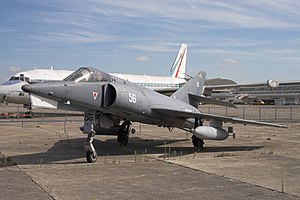Dassault Étendard IV
| Dassault Étendard IV | |
|---|---|

|
|
| Type: | carrier-based fighter |
| Design country: | |
| Manufacturer: | |
| First flight: |
May 21, 1958 |
| Commissioning: |
1962 |
| Number of pieces: |
90 |
The Dassault Étendard (Standard) was a single-engine , carrier-supported fighter aircraft produced by the French manufacturer Dassault Aviation .
history
In the mid-1950s, various NATO air forces were looking for a light, inexpensive offensive fighter aircraft. Dassault then began planning such an aircraft. Initially, three prototypes were built, which were designated with Roman numerals (II, VI, IV). The development of the prototype II, known as Étendard II (first flight 23 July 1956), was discontinued because it had problems with the drive (twin-engine, but still underpowered) and the development of the single-engine prototype VI (first flight 15 March 1957), because NATO chose the Fiat G.91 as a light tactical fighter aircraft.
Prototype IV (first flight July 24, 1956) was equipped with a larger tank and more thrust and was further developed by Dassault at its own expense. In 1956, the French Navy Air Force registered an interest in the Dassault Étendard IV. The aircraft intended for the Navy was further developed as the Étendard IVM. In its first order, the Navy ordered a prototype - which flew for the first time on May 21, 1958 - and six pre-production aircraft. These aircraft were modified for aircraft carrier use compared to the IV. A total of 69 aircraft were built by the Étendard IVM. They began their service in 1962 on board the aircraft carriers Clemenceau and Foch . A special feature of the machines is that they were not equipped with a radar, but only with a sword-shaped antenna under the bow. Since this type was very successful, the Super Étendard was then developed. The last Étendard IVMs were decommissioned in mid-1991.
variants

Étendard IV: This was the first prototype (still equipped with a Snecma Atar 101E engine) that was built by Dassault at its own expense and then modified for the Navy.
Étendard IVM: This was the standard marine version. Compared to the IV, these aircraft had an enlarged wing with a sawtooth leading edge, folding outer wings, a larger rudder , a reinforced landing gear , an air refueling device, catapult attachment and catch hook . They were equipped with a pressurized cabin and a retractable landing gear, each with three wheels with single tires, a fire control system called AIDA and a Saab bomb target computer.
Étendard IVB: There was only one prototype of this variant. This variant had a Rolls-Royce Avon Mk.51 as a drive and inflated landing flaps.
Étendard IVP: These unarmed aircraft were built as reconnaissance aircraft and air tankers for the Étendard IVM. The main differences were two or three Omera reconnaissance cameras and the equipment for air refueling. In addition to a rigid air refueling probe , this version also had a hose reel container for “buddy refueling”. A total of 21 pieces were made.
Military users
Technical specifications
| Parameter | Dassault Étendard IVM |
|---|---|
| length | 14.31 m |
| span | 9.60 m |
| height | 3.86 m |
| Wing area | 28.40 m² |
| Empty mass | 6,450 kg |
| Max. Takeoff mass | 11,500 kg |
| Engine | a SNECMA Atar 8B jet engine with 43.16 kN thrust |
| Top speed | 1205 km / h |
| Service ceiling | 13,045 m |
| Range | 2092 km |
Armament
- two 30 mm DEFA cannons with 150 rounds each
- Gun loads of up to 1,360 kg at four external load stations:
- AM 39 Exocet
- AIM-9 Sidewinder
- AN52 atomic bombs
- Additional tanks
See also
Web links
- Manufacturer website (English)
Individual evidence
- ↑ FliegerRevue July 2008, pp. 26–30, More combat power for the Super Etendard

